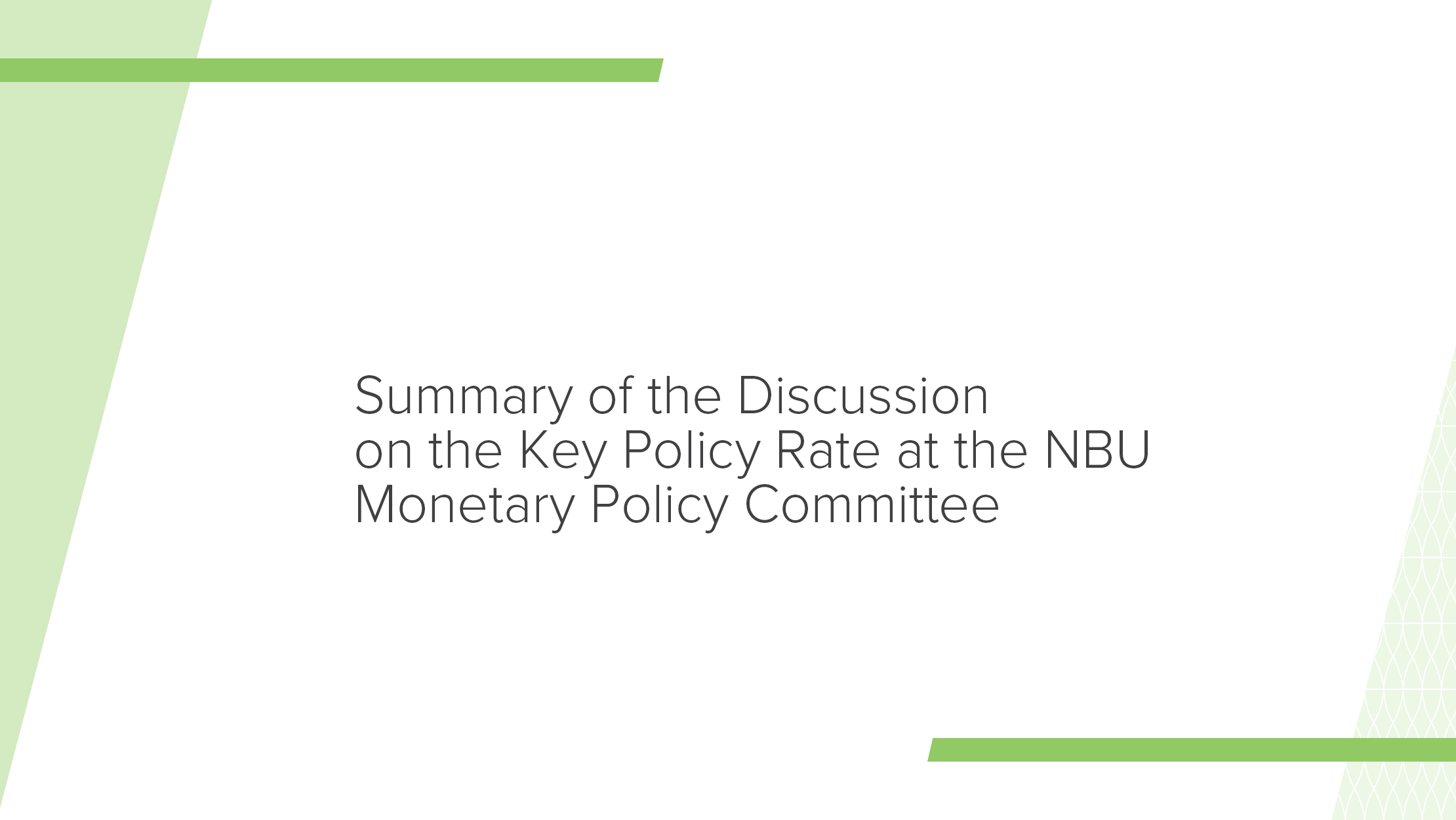Date of the meeting: 10 June 2020
Attendees: All ten members of the NBU Monetary Policy Committee (MPC):
- Yakiv Smolii - Governor of the National Bank of Ukraine
- Kateryna Rozhkova - First Deputy Governor
- Roman Borysenko - Deputy Governor
- Dmytro Sologub - Deputy Governor
- Sergii Kholod - Deputy Governor
- Oleg Churiy - Deputy Governor
- Vitalii Vavryshchuk – Director of the Financial Stability Department
- Volodymyr Lepushynskyi - Director of the Monetary Policy and Economic Analysis Department
- Yurii Polovniov - Director of the Statistics and Reporting Department
- Serhii Ponomarenko - Director of the Open Market Operations Department.
The gradual lifting of quarantine restrictions has contributed to the revival in economic activity, the MPC members pointed out at the meeting. At the same time, there is a significant risk that the economic fallout from the COVID-19 pandemic will be deeper and longer-lasting than previously anticipated. The spike in unemployment, coupled with weak wage growth, will slow the recovery in consumption. Investment demand will also be subdued, in particular due to deteriorating financial performance and corporate expectations. Therefore, the economy needs both fiscal and monetary stimuli.
Maintaining low inflation makes it possible to pursue economic stimulus policies. In May 2020, consumer inflation declined to 1.7% in annual terms, down from 2.1% in April. Inflationary pressures remain weak due to slack consumer demand, relatively low energy prices, and favorable FX market conditions. In the medium term, inflation will grow, though at a moderate pace, driven by a gradual resumption of economic activity, rising energy prices, and the fading effects of a high base of comparison and last year’s strong hryvnia. However, it will take longer than expected for inflation to return to the 5% ± 1 pp target range.
The MPC members welcomed the signing of the new program of cooperation between Ukraine and the IMF, an important assumption in the NBU’s macroeconomic forecast. This long-awaited event will have a positive impact on inflationary and depreciation expectations.
Under these conditions, the NBU is able to act more decisively. The monetary policy easing will support economic recovery without putting macrofinancial stability at risk.
In June, the key policy rate should be reduced by 200 bp, to 6%, the MPC members unanimously agreed.
However, the MPC members expressed differing expectations about the further dynamics of the key policy rate.
Significant uncertainty remains about the duration and intensity of the quarantine, as well as the speed of recovery in consumer demand and economic activity, both in Ukraine and the rest of the world. This uncertainty will affect inflationary dynamics, most MPC members said.
Consumer demand will not recover quickly in the short run, some MPC members said. In that case, the balance of inflation risks will allow the NBU to cut the key policy rate to a value that is actually below the neutral (equilibrium) level. The unprecedented monetary easing efforts in other countries may even push Ukraine’s neutral level of the key policy rate down further.
In contrast, some MPC members did not rule out stronger inflationary pressures in the short term. Inflation may accelerate as consumer demand recovers after quarantine measures are lifted. Higher fuel prices, driven by the growth in oil prices, as well as the gradual “thawing” of prices for a significant number of services that were previously subject to quarantine restrictions, may also speed up inflation. In that case, in order to prevent an inflationary surge and a loss of public confidence in the NBU’s actions, the central bank will have to tighten its monetary policy by raising the key policy rate in the medium term to at least the neutral level.
Going forward, the dynamics of the key policy rate will depend not only on inflation developments, but also on changes in the value of alternative assets, several MPC members said. In particular, as the interest rate differential between FX- and hryvnia-denominated assets narrows, the risk of capital outflows from Ukraine and a dollarization of its economy rises. This factor can also hinder the easing of monetary policy.
The MPC members also discussed a further reduction in the key policy rate in terms of how the monetary transmission mechanism could perform. The current nominal level of the key policy rate is the lowest in the history of independent Ukraine. The key policy rate cuts in 2020 have been rather deep. With this in mind, commercial banks and other economic agents will need more time to adapt to the new, low-interest-rate environment, and to rethink their strategies and business models. As a result, other interest rates in the economy may respond rather slowly to the easing of monetary policy.
Under current conditions, the monetary transmission mechanism could also be hampered by the stickiness of interest rates on term deposits, as banks may be reluctant to cut them. Banks are cautious in revisiting their interest rate policies, especially in the retail segment, given the outflow of cash from the banking system at the beginning of the corona crisis and the likelihood that the pandemic may take a turn for the worse. In addition, the risk premium in the structure of loan rates increases in times of crisis.
The potential for an intensive monetary policy easing is almost exhausted, an overwhelming majority of the MPC members agreed.
The MPC members also discussed the feasibility of narrowing the NBU’s interest rate corridor for standing facilities. With the key policy rate as low as it is now, the rate corridor for standing facilities should be narrowed to +/- 1 pp, most MPC members suggested. The new corridor will enable the NBU to more effectively pursue the operational target of its monetary policy, which is to keep hryvnia interbank rates close to the key policy rate.
The decision to set the key policy rate at 6.0% per annum was approved by the NBU Board at the monetary policy meeting held on 11 June 2020.
The Monetary Policy Committee (MPC) is the NBU’s advisory body created to share information and opinions on monetary policy formulation and implementation in order to deliver price stability. The MPC comprises the NBU Governor, other NBU Board members, and directors of the Monetary Policy and Economic Analysis, Open Market Operations, Financial Stability, and Statistics and Reporting Departments. The MPC meets the day before the NBU Board meeting on monetary policy issues. Decisions on monetary policy issues are made by the NBU Board.


